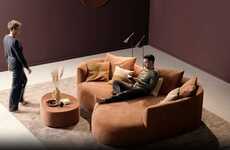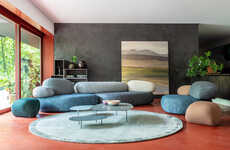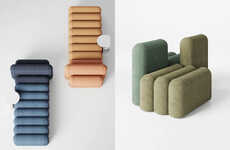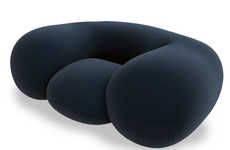
The Baby Flirtstone by Filippo Dell’Orto is Made for Public Spa
Meghan Young — July 16, 2013 — Art & Design
References: sphaus.it & contemporist
Made with public spaces such as hotel rooms, lobbies, lounge areas and waiting rooms in mind, the Baby Flirtstone is a piece of furniture that focuses as much on form as it does on function. It takes on a large organic, asymmetrical shape that could easily fit two people comfortably. Nevertheless, the designers note that it is limited in dimension despite its appearance.
Created by Filippo Dell’Orto for spHaus, the Baby Flirtstone takes on a rounded form that is mimicked in its accompanying footstool. Made out of fire retardant polyurethane foam, the fabric or leather (depending on what the owners opt for) is removable and thus easily cleaned. The Baby Flirtstone was designed to expand the Flirtstone furiture collection by spHaus.
Created by Filippo Dell’Orto for spHaus, the Baby Flirtstone takes on a rounded form that is mimicked in its accompanying footstool. Made out of fire retardant polyurethane foam, the fabric or leather (depending on what the owners opt for) is removable and thus easily cleaned. The Baby Flirtstone was designed to expand the Flirtstone furiture collection by spHaus.
Trend Themes
1. Organic Seating - Developing seating options that take up more space and use organic shapes and materials is a disruptive innovation opportunity in the hospitality and public space industries.
2. Modular Furniture - Creating modular furniture collections with interchangeable pieces and customizable materials is a potential disruptive innovation opportunity in the furniture design and manufacturing industries.
3. Sustainable Materials - Exploring the use of sustainable materials such as recycled foam or eco-friendly fabrics for furniture manufacturing is a potential disruptive innovation opportunity in the interior design and sustainability industries.
Industry Implications
1. Hospitality - Designing and manufacturing furniture for the hospitality industry that uses organic shapes and materials could provide a competitive edge.
2. Public Spaces - Developing furniture collections specifically designed for public spaces that prioritize functionality and aesthetics can be a lucrative opportunity for businesses in the furniture and interior design industries.
3. Sustainability - The furniture manufacturing industry can adopt sustainable materials and manufacturing processes to appeal to environmentally conscious consumers and contribute to a sustainable future.
0.8
Score
Popularity
Activity
Freshness























